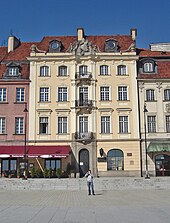Prażmowski Palace

The Prażmowski Palace (also known as Leszczyński , Rautenstrauch , Dobrycz or Pastorius Palace or apartment building ; Polish: Pałac or Kamienica Prażmowskich , Leszczyńskich , Rautenstrauchów , Dobrycza or Joachima Pastoriusa ) is a late-Baroque city palace from the 17th century . Century, which is located at the beginning of the historic Royal Route in Warsaw's inner city district. The property is located on Warsaw Palace Square and has the address Ulica Krakowskie Przedmieście 87 . The rear wing is on Senatorska Street .
history
In the middle of the 17th century the property belonged to the Warsaw judge K. Walter. From 1660 to 1667 a three-storey building in the baroque style was built here for the court doctor of King John II Casimir , Joachim Pastorius . This building had four window axes to Krakowskie Przedmieście . Shortly afterwards, Mikołaj Prażmowski bought the property.
Reconstruction under the Leszczyńskis
In the middle of the 18th century the magnate family Leszczyński took over the residence. Among them, Giacomo Fontana completely rebuilt the building from around 1754 to 1770. One floor was added, the front facade was given a fifth window axis and was now designed in a late Baroque style with Rococo elements . Presumably during the renovation phase, the rear wing on Senatorska was also created , which in any case received a new facade decoration in 1795 (also in the Rococo style).
After the Rautenstrauch family owned it for a short time , the palace belonged to the merchant Dobrycz from 1804.
World War II and post-war period
The building was partially destroyed during the Warsaw Uprising in 1944. Remaining remains were removed immediately after the war, as the tunnel for the newly routed east-west connection Trasa WZ was built under the building . In 1948 and 1949 the house with its late eighteenth-century appearance was rebuilt on the tunnel ceiling based on a design by Zygmunt Stępiński . The ensemble of buildings today consists of the main building on Krakowskie Przedmieście , a side wing along the neighboring John House and a rear wing along Ulica Senatorska . The facade facing Krakowskie Przedmieście is late Baroque, the facade facing Senatorska with seven window axes is classical . Inside, the ensemble was connected to the John House . It was extensively renovated from 2002 to 2003. Today, the building called "Dom Literatury" houses the headquarters of the Polish Writers' Union (Polish: Związek Literatów Polskich ) and the “Literatka” restaurant on Krakowskie Przedmieście .
Individual evidence
- ↑ Joachim Pastorius (also: Joachim Pastorius de Hirtenberg, Joachim Hirthenius, Joachim ab Hirtenberg, Joachim ab Hirtenberg, Joachimus Pastorius; 1611–1681) was a Polish doctor, civil servant and poet
- ↑ Mikołaj Jan Prażmowski (1617–1673) was a Polish politician, archbishop and primate and from 1668 to 1669 Interrex of the country
- ↑ according to Janina Rukowska, Travel Guide Warsaw and Surroundings , 3rd edition, ISBN 83-217-2380-2 , Sport i Turystyka, Warsaw 1982, p. 70
See also
literature
- Julius A. Chroscicki and Andrzej Rottermund, Architectural Atlas of Warsaw , 1st edition, Arkady, Warsaw 1978, p. 85 f.
Web links
- Description and historical recordings at Warszawa1939.pl (in Polish)
Coordinates: 52 ° 14 '48.7 " N , 21 ° 0' 47.4" E


